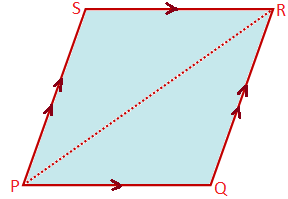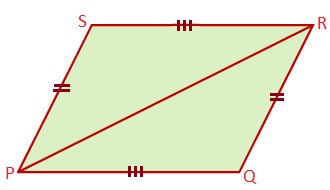Subscribe to our ▶️ YouTube channel 🔴 for the latest videos, updates, and tips.
Opposite Sides of a Parallelogram are Equal
Here we will discuss about the opposite sides of a parallelogram are equal in length.
In a parallelogram, each pair of opposite sides are of equal length.
Given: PQRS is a parallelogram in which PQ ∥ SR and QR ∥ PS.
To prove: PQ = SR and PS = QR
Construction: Join PR
Proof:
|
Statement In ∆PQR and ∆RSP; 1. ∠QPR = ∠SRP 2. ∠QRP = ∠RPS 3. PR = PR 4. ∆PQR ≅ ∆RSP 5. PQ = SR and PS = QR. (Proved) |
Reason 1. PQ ∥ RS and RP is a transversal. 2. PS ∥ QR and RP is a transversal. 3. Common side 4. By ASA criterion of congruency. 5. CPCTC |
Converse of the above given theorem
A quadrilateral is a parallelogram if each pair of opposite sides are equal.
Given: PQRS is a quadrilateral in which PQ = SR and PS = QR
To prove: PQRS is a parallelogram
Proof: In ∆PQR and ∆RSP, PQ = SR, QR = SP (given) and PR is the common side.
Therefore, by SSS criterion of congruency, ∆PQR ≅ ∆RSP
Therefore, ∠QPR = ∠PRS, ∠QRP = ∠RPS (CPCTC)
Therefore, PQ ∥ SR, QR ∥ PS
Hence, PQRS is a parallelogram.
Solved examples based on the theorem of opposite sides of a parallelogram are equal in length:
1. In the parallelogram PQRS, Pq = 6 cm and SR : RQ = 2 : 1. Find the perimeter of the parallelogram.
Solution:
In the parallelogram PQRS, PQ ∥ SR and SP ∥ RQ.
The opposite sides of a parallelogram are equal. So, SR + PQ = 6 cm.
AS SR : RQ = 23 : 1, \(\frac{6 cm}{RQ}\) = \(\frac{2}{1}\)
⟹ RQ = 3 cm
Also, RQ = SP = 3 cm.
Therefore, perimeter = PQ + QR + RS + SP
= 6 cm + 3 cm + 6 cm + 3 cm
= 18 cm.
2. In the parallelogram ABCD, ∠ABC = 50°. Find the measures of ∠BCD, ∠CBA and ∠DAB.
Solution:
AS AB ∥ DC, ∠ABC + ∠BCD = 180°
Therefore, ∠BCD = 180° - ∠ABC
= 180° - 50°
= 130°
As opposite angles in a parallelogram are equal,
∠CDA = ∠ABC = 50° and
∠DAB = ∠BCD = 130°From Opposite Sides of a Parallelogram are Equal to HOME PAGE
Didn't find what you were looking for? Or want to know more information about Math Only Math. Use this Google Search to find what you need.




New! Comments
Have your say about what you just read! Leave me a comment in the box below. Ask a Question or Answer a Question.